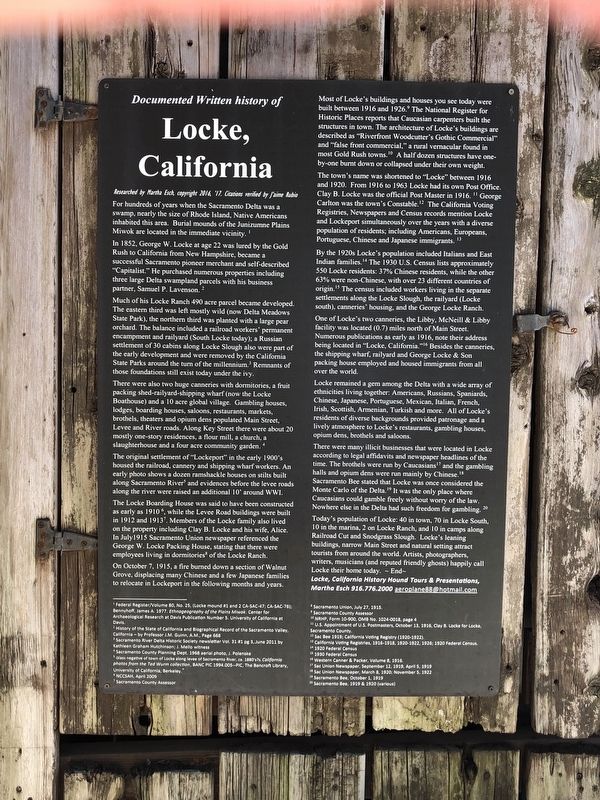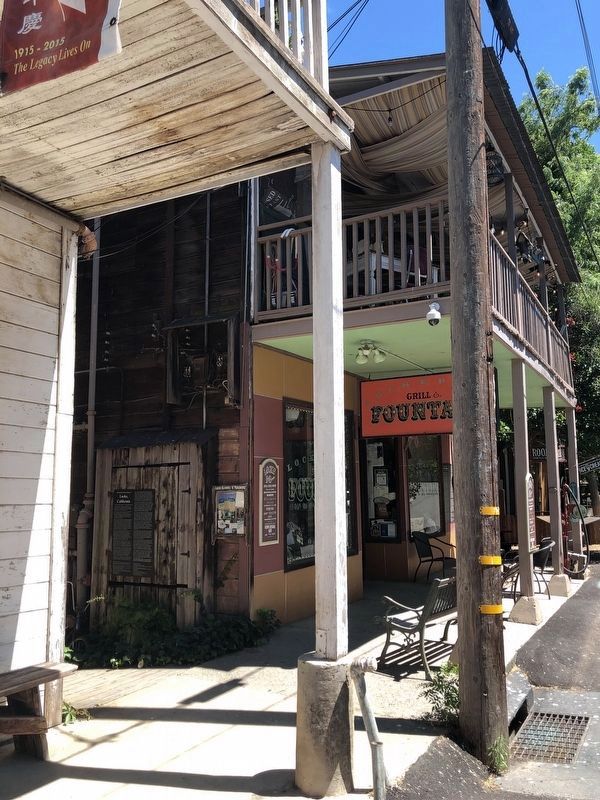Locke in Sacramento County, California — The American West (Pacific Coastal)
Locke, California
For hundreds of years when the Sacramento Delta was a swamp, nearly the size of Rhode Island, Native Americans inhabited this area. Burial mounds of the Junisumne Plains Miwok are located in the immediate vicinity¹
In 1852, George W. Locke at age 22 was lured by the Gold Rush to California from New Hampshire, became a successful Sacramento pioneer merchant and self-described "Capitalist." He purchased numerous properties including three large Delta swampland parcels with his business partner, Samuel P. Lavenson.²
Much of his Locke Ranch 490 acre parcel became developed. The eastern third was left mostly wild (now Delta Meadows State Park), the northern third was planted with a large pear orchard. The balance included a railroad workers' permanent encampment and rail yard (South Locke today); a Russian settlement of 30 cabins along Locke Slough also were part of the early development and were removed by the California State Parks around the turn of the millennium.³ Remnants of those foundations still exist today under the ivy.
There were also two huge canneries with dormitories, a fruit packing shed-railyard-shipping wharf (now the Locke Boathouse) and a 10 acre global village. Gambling houses, lodges, boarding houses, saloons, restaurants, markers, brothels, theaters and opium dens populated Main Street, Levee and River roads. Along Key Street there were about 20 mostly one-story residences, a flour mill, a church, a slaughterhouse and a four acre community garden.⁴
The original settlement of "Lockeport" in the early 1900's housed the railroad, cannery and shipping wharf workers. An early photo shows a dozen ramshackle houses on stilts built along Sacramento River⁵ and evidences before the levee road along the river were raised an additional 10' around WWI.
The Locke Boarding House was said to have been constructed as early as 1910⁶, while the Levee Road buildings were built in 1912 and 1913⁷. Members of the Locke family also lived on the property including Clay B. Locke and his wife, Alice. In July 1915 Sacramento Union newspaper reference the George W. Locke Pacing House, stating that there were employees living in dormitories⁸ of the Locke Ranch.
On October 7, 1915, a fire burned down a section of Walnut Grove, displacing many Chinese and a few Japanese families to relocate in Lockeport in the following months and years.
Most of Locke's buildings and houses you see today were built between 1916 and 1926.⁹ The National Register for Historic Places reports that Caucasian carpenters built the structures in town. The architecture of Locke's buildings
are described as "Riverfront Woodcutter's Gothic Commercial" and "false front commercial," a rural vernacular found in most Gold Rush towns.¹⁰ A half dozen structures have one-by-one burnt down or collapsed under their own weight.
The town's name was shortened to "Locke" between 1916 and 1920. Form 1916 to 1963 Locke had its own Post Office. Clay B. Locke was the official Post Master in 1916.¹¹ George Carlton was the town's Constable.¹² The California Voting Resistries, Newspaper and Census records mention Locke and Lockport simultaneously over the years with a diverse population of residents; including Americans, Europeans, Portuguese, Chinese and Japanese immigrants.¹³
By the 1920s Locke's population included Italians and East Indian families.¹⁴ The 1930 U.S. Census list approximately 550 Locke residents: 37% Chinese residents, while the other 63% were non-Chinese, with over 23 different countries of origin.¹⁵ The census included workers living in the separate settlements along the Locke Slough, the railyard (Locke south), canneries' housing, and the George Locke Ranch. One of Locke's two canneries, the Libby, McNeill & Libby facility was located (0.7) miles north of Main Street. Numerous publications as early as 1916, note their address being located in "Locke, California."¹⁶ Besides the canneries, the shipping wharf, railyard and George Locke and Son packing house employed and house immigrants from all over the world.
Locke remained a gem among the Delta with a wide array of ethnicities living together: Americans, Russians, Mexican, Italian, French, Irish, Scottish, Armenian, Turkish, and more. All of Locke's residents of diverse backgrounds provided patronage and a living atmosphere to Locke's restaurants. gambling houses, opium dens, brothels and saloons.
There were many illicit businesses that were located in Locke according to legal affidavits and newspapers headlines of the time. The brothels were run by Caucasians¹⁷ and the gambling halls and opium dens were run mainly by Chinese.¹⁸ Sacramento Bee stated that Locke was once considered the Monte Carlo of the Delta.¹⁹ It was the only place where Caucasians would gamble freely without worry of the law. Nowhere else is the Delta had such freedom for gambling.²⁰
Today's population of Locke: 40 in town, 70 in Locke South, 10 in the marina, 2 on Locke Ranch, and 10 in camps along Railroad Cut and Snodgrasss Slough. Locke's leaning buildings, narrow Main Street and natural setting attract tourists from around the world. Artists, photographers, writers, musicians (and reputed friendly ghosts) happily call Locke their home today. ~End~
(To consult the footnotes, click on the image of the marker to enlarge it and read the text.)
Erected by History Hound Tours and Presentations.
Topics. This historical marker is listed in these topic lists: Asian Americans • Settlements & Settlers.
Location. 38° 15.016′ N, 121° 30.569′ W. Marker is in Locke, California, in Sacramento County. Marker is on Main Street near Levee Street, on the left when traveling west. There are two identical markers, one on the front and another on the side of the same building. Touch for map. Marker is at or near this postal address: 13959 Main Street, Walnut Grove CA 95690, United States of America. Touch for directions.
Other nearby markers. At least 8 other markers are within walking distance of this marker. A different marker also named Locke (within shouting distance of this marker); Locke Memorial Park (within shouting distance of this marker); Locke / 樂居镇 (within shouting distance of this marker); Welcome to Locke (about 400 feet away, measured in a direct line); Delta Transmission Towers/Delta Cross Channel Gates (approx. 0.2 miles away); Charles “Chuck” Tison (approx. 0.2 miles away); Walnut Grove, Est. 1850/Locke, Est. 1915 (approx. 0.2 miles away); Boon-Dox Botel (approx. half a mile away). Touch for a list and map of all markers in Locke.
Credits. This page was last revised on February 7, 2023. It was originally submitted on June 12, 2020, by Barry Swackhamer of Brentwood, California. This page has been viewed 373 times since then and 47 times this year. Photos: 1, 2. submitted on June 12, 2020, by Barry Swackhamer of Brentwood, California.

